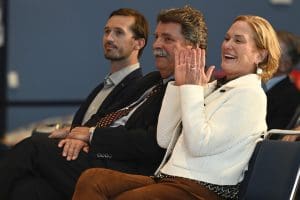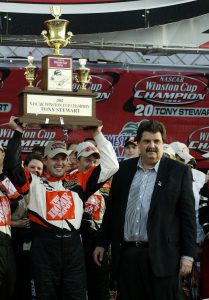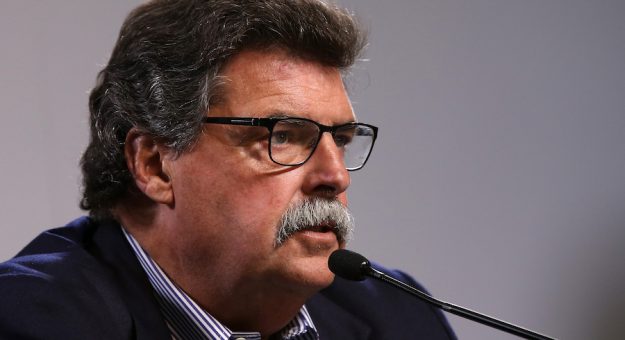Mike Helton is the bridge between NASCAR’s past under the direction of “Big Bill” France and Bill France Jr., and its future with Ben Kennedy.
It has been a quarter century since February 2000 when the native of Bristol, Va., was introduced to the media at Daytona Int’l Speedway as the new president of NASCAR, succeeding Bill France Jr. Helton had previously been NASCAR’s vice president of competition since 1994.
Brian France, Bill France Jr.’s son, was named CEO that same day as the France family was preparing for one of the most important times in the sanctioning body’s history.
Helton served as president until 2015 when he became NASCAR vice chairman.
Today, Helton is a NASCAR senior adviser as he reflects on the last 25 years and the impact of his leadership.
“There’s a lot of things that happened and it has all seemed to happen very quickly in a lot of ways,” Helton told SPEED SPORT. “I ran Atlanta Int’l Raceway and thought I knew a lot about the sport. I went to Talladega and ran that for the France family and thought I advanced my experience in the industry and the sport and the people.

“But when I came to the NASCAR side from the track operating side, I had no idea of the difference and the magnitude of what the sanctioning body really did. I thought I did, but I didn’t.
“I got into NASCAR and just happened to have been the right person at the right time for the things going on and the growth of the sport and the growth of NASCAR itself. I never trained for it. I never planned on it. It just worked out.
“When I sit today and flash back on all of that and understand the moments and the magnitude of things that happened, some slowly, some very quickly, the changes, it’s truly overwhelming.”
Helton was the first NASCAR president who wasn’t named France. It was an immense move.
“That’s a lot of pressure,” Helton admitted. “Following Bill France Sr. and Bill France Jr. into the leadership role of the sport that was growing, that was a tremendous amount of pressure. But I knew I had good support through Bill France, Jim France and Brian and Lesa (France Kennedy), and the other employees like Les Richter, Jim Hunter and the folks from that era.
“Also, it wasn’t like I had to walk in and fix anything. It was genuinely in good shape. It wasn’t as if I was brought in to change up things and correct stuff. It was tracking well, and my job was to simply keep it going that way.”
Helton was extremely confident because he had Bill France Jr. as his mentor.
“It was like every professor and every major or minor institution in this whole country, but the course was common sense,” Helton said of France. “His mentorship was basic fundamentals of keeping your head straight but using common sense.
“Read the dinner table, the meeting room, the individual across the table from you, but understanding your obligation to the shareholders and stakeholders of the sport and how all of that is put together. That all relied on common sense and street sense.”
At that time, the Daytona 500 still aired on CBS. NASCAR Cup Series races were televised on ESPN, TBS, The Nashville Network and ABC. Dale Earnhardt was the face of NASCAR, but new stars such as Jeff Gordon and Tony Stewart were moving the stock car racing series into the mainstream.
NASCAR was about to change and change in a very dramatic way under Helton and Brian France.
A new television contract was reached with FOX Sports and NBC. TV viewing was being simplified as NASCAR Cup Series races would be televised, for the most part, with every race on a major network.
That helped dramatically expand NASCAR’s footprint.

“That was a big move for us, and it wasn’t easy, and it didn’t come overnight,” Helton recalled. “It took two or three years to get to that point. We were really fortunate to have great relationships with ESPN, TNT/TBS, The Nashville Network and CBS.
“We had really good partners but what we were after was to make it easier to find the sport, to create some more continuity out of it.”
Prior to that, NASCAR held the television rights each year, but gave them back to the race tracks to negotiate their own deals. Different tracks had deals with different networks.
“As we evolved and got bigger, the media coverage grew on cable and FOX stepped into the fray and became the fourth network. We went to work in the late 1990s in pulling those rights back in and selling the NASCAR Cup Series as a package, as opposed to a weekend,” Helton explained. “That began the relationship we are still in today.”
There have been changes to the NASCAR television package since then, with NBC leaving, ESPN returning in 2007 and then leaving again after the 2014 season and NBC coming back in 2015.
But during the offseason, NASCAR announced its latest media rights contract that is worth $7.7 billion over seven years beginning in 2025.
FOX and NBC remain as key, over-the-air network partners, but it brings in new partners including Warner Brothers Discovery/TNT and Amazon, with each broadcasting five NASCAR Cup Series races during the summer starting in 2025.
Amazon Prime Video and the Max streaming service will move NASCAR into the streaming age.
“It’s huge because it is the modern way of consuming entertainment,” Helton said. “We are fortunate to have relationships with our new partners that want to use NASCAR as part of that entertainment package that will take us all around the world because of the evolution of consuming entertainment with streaming being a big part of that.”
The growth of NASCAR’s television package was a major part of Helton’s tenure, but there were other dramatic events that shaped that era, including the Feb. 18, 2001, death of Dale Earnhardt during a crash on the final lap of the Daytona 500.
The job of delivering the sad news was Helton’s.
“This is undoubtedly one of the toughest announcements that I’ve ever personally had to make,” Helton said at the time. “But after the accident in turn four at the end of the Daytona 500, we’ve lost Dale Earnhardt.”
To this day, those words remain a haunting moment in the 76-year history of NASCAR.
“I don’t know that you can compare it to any other watershed mark,” Helton said. “Certainly, it was a day that anybody in our generation is going to remember.
“It is like Nov. 22, 1963, or Dec. 7, 1941. Those dates, you can remember where you were and what you were doing exactly when it happened all these years later.
“That will be a day that in the motorsports world and NASCAR in particular, everybody following the sport that day will remember that day. It is certainly one that is in all of our brains.”
Earnhardt’s death forced NASCAR to make major changes, including the use of head-and-neck restraint systems, SAFER barriers and better designed and constructed race cars.
Those changes occurred under Helton’s leadership.
“I don’t know if pride is the right word, but I am proud of NASCAR and I’m proud of all the people that stepped up to the plate after that moment,” Helton said. “In 1999 and 2000, we were having things happen on the race track and didn’t have good answers or reactions to them. We were trying to react correctly, whether it was a throttle piece that Jack Roush was working on after we lost Adam Petty and Kenny Irwin in New Hampshire.
“When that happened in February 2001, it ignited a very large work force around making motorsports safer.
“Even before that, Tony George and Bill France Jr. were working on the SAFER barrier, but that was going to be a while to get it where it is today. The HANS Device is something that drivers weren’t sure about yet.
“But when we had that happen in February 2001, it fast-forwarded all the projects that might have been out there, created a lot of the new ones and has maintained a high level of importance from every NASCAR member out there.
“It advanced the topic of safety and made it No. 1. That effort will continue, but the era that got it to that point and people wanting to keep it to that point is a moment I can look back and say I’m glad I was here, not to see the reason for it, but to see the results of it.”
From “Big Bill” France and Bill France, Jr. in the past, to Ben Kennedy in the future, Mike Helton is the bridge at NASCAR.
“It goes so quick, but when you can respond to the things that have evolved, I have a high level of comfort and confidence that NASCAR, the sporting part of it, the entertainment part of it, but the family part of it, with the fourth generation maintaining that culture is very rewarding to me,” Helton said. “I like the fact that Steve Phelps, Steve O’Donnell and John Probst, the people leading the company today, are race fans.
“That makes NASCAR better, stronger and more promising.”
This story appeared in the Feb. 14 edition of the SPEED SPORT Insider.

